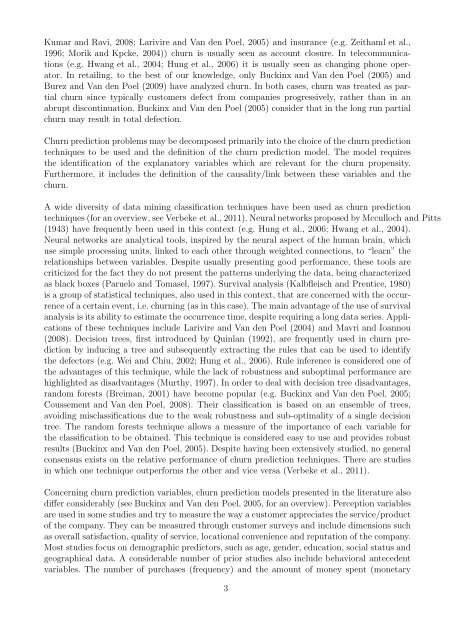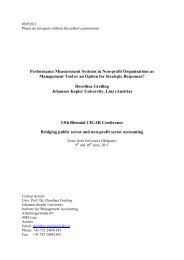Predicting Partial Customer Churn Using Markov for Discrimination ...
Predicting Partial Customer Churn Using Markov for Discrimination ...
Predicting Partial Customer Churn Using Markov for Discrimination ...
You also want an ePaper? Increase the reach of your titles
YUMPU automatically turns print PDFs into web optimized ePapers that Google loves.
Kumar and Ravi, 2008; Larivire and Van den Poel, 2005) and insurance (e.g. Zeithaml et al.,<br />
1996; Morik and Kpcke, 2004)) churn is usually seen as account closure. In telecommunications<br />
(e.g. Hwang et al., 2004; Hung et al., 2006) it is usually seen as changing phone operator.<br />
In retailing, to the best of our knowledge, only Buckinx and Van den Poel (2005) and<br />
Burez and Van den Poel (2009) have analyzed churn. In both cases, churn was treated as partial<br />
churn since typically customers defect from companies progressively, rather than in an<br />
abrupt discontinuation. Buckinx and Van den Poel (2005) consider that in the long run partial<br />
churn may result in total defection.<br />
<strong>Churn</strong> prediction problems may be decomposed primarily into the choice of the churn prediction<br />
techniques to be used and the definition of the churn prediction model. The model requires<br />
the identification of the explanatory variables which are relevant <strong>for</strong> the churn propensity.<br />
Furthermore, it includes the definition of the causality/link between these variables and the<br />
churn.<br />
A wide diversity of data mining classification techniques have been used as churn prediction<br />
techniques (<strong>for</strong> an overview, see Verbeke et al., 2011). Neural networks proposed by Mcculloch and Pitts<br />
(1943) have frequently been used in this context (e.g. Hung et al., 2006; Hwang et al., 2004).<br />
Neural networks are analytical tools, inspired by the neural aspect of the human brain, which<br />
use simple processing units, linked to each other through weighted connections, to “learn” the<br />
relationships between variables. Despite usually presenting good per<strong>for</strong>mance, these tools are<br />
criticized <strong>for</strong> the fact they do not present the patterns underlying the data, being characterized<br />
as black boxes (Paruelo and Tomasel, 1997). Survival analysis (Kalbfleisch and Prentice, 1980)<br />
is a group of statistical techniques, also used in this context, that are concerned with the occurrence<br />
of a certain event, i.e. churning (as in this case). The main advantage of the use of survival<br />
analysis is its ability to estimate the occurrence time, despite requiring a long data series. Applications<br />
of these techniques include Larivire and Van den Poel (2004) and Mavri and Ioannou<br />
(2008). Decision trees, first introduced by Quinlan (1992), are frequently used in churn prediction<br />
by inducing a tree and subsequently extracting the rules that can be used to identify<br />
the defectors (e.g. Wei and Chiu, 2002; Hung et al., 2006). Rule inference is considered one of<br />
the advantages of this technique, while the lack of robustness and suboptimal per<strong>for</strong>mance are<br />
highlighted as disadvantages (Murthy, 1997). In order to deal with decision tree disadvantages,<br />
random <strong>for</strong>ests (Breiman, 2001) have become popular (e.g. Buckinx and Van den Poel, 2005;<br />
Coussement and Van den Poel, 2008). Their classification is based on an ensemble of trees,<br />
avoiding misclassifications due to the weak robustness and sub-optimality of a single decision<br />
tree. The random <strong>for</strong>ests technique allows a measure of the importance of each variable <strong>for</strong><br />
the classification to be obtained. This technique is considered easy to use and provides robust<br />
results (Buckinx and Van den Poel, 2005). Despite having been extensively studied, no general<br />
consensus exists on the relative per<strong>for</strong>mance of churn prediction techniques. There are studies<br />
in which one technique outper<strong>for</strong>ms the other and vice versa (Verbeke et al., 2011).<br />
Concerning churn prediction variables, churn prediction models presented in the literature also<br />
differ considerably (see Buckinx and Van den Poel, 2005, <strong>for</strong> an overview). Perception variables<br />
are used in some studies and try to measure the way a customer appreciates the service/product<br />
of the company. They can be measured through customer surveys and include dimensions such<br />
as overall satisfaction, quality of service, locational convenience and reputation of the company.<br />
Most studies focus on demographic predictors, such as age, gender, education, social status and<br />
geographical data. A considerable number of prior studies also include behavioral antecedent<br />
variables. The number of purchases (frequency) and the amount of money spent (monetary<br />
3
















